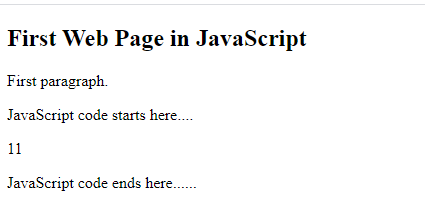Introduction to JavaScript
Introduction
In this chapter, we will learn about Introduction to JavaScript, its basic terms, syntaxes, and how JavaScript is different from Java Programming language with example programs.
JavaScript
Javascript is the first scripting programming language that supports browsers and the most popular scripts. JavaScript is the programming language of the Web, and it is an interpreted programming language.
Interpreter means converting the
JavaScript code into whichever computer language the machine knows; this conversion happens when the code
is run; and it must be repeated once the code is run.
JavaScript is used to make HTML Pages live within HTML Pages. The name JavaScript is similar to Java but it is different from Java Programming Language and in fact, Java was in use before the JavaScript Language.
History of JavaScript
JavaScript was created in May 1995 by Brendan Eich at Netscape and in 10 days the first version of JavaScript was ready. The original name of JavaScript was Mocha, named by the founder of Netscape.
In September 1995 the name of JavaScript was changed to Live Script from Mocha. Again in December 1995, the name changed from LiveScript to JavaScript.
Features of JavaScript
- JavaScript is a light-weight language.
- JavaScript is a case sensitive and object-based scripting language.
- JavaScript is an untyped language, it means we don't need to define the data type of the variables.
- Gives the user more control over the browser.
- Every statement in Javascript terminates with a semicolon (;).
- Most of the Javascript control statements syntax is the same as the syntax of control statements in C and Java language.
- JavaScript has built-in functions to determine the date and time.
Why do we use JavaScript?
JavaScript is used in web pages to add functionality, validation forms, communicate with the server, and read-write HTML elements. JavaScript is a client-side scripting language. All the browsers support JavaScript language and it makes our website more attractive and light-weight. JavaScript enhances the efficiency of our websites.
JavaScript is often used for modifying the state. Suppose we're clicking on the button or some connection event server will give us a whole new page to look at, but JavaScript will do it on the client-side.
Advantages of JavaScript
- Make the HTML page more interactive.
- JavaScript is very easy to learn and understand.
- JavaScript increases the performance of websites and web applications by raising the length of code
- Execute code on events.
- Get/Set the Cookies, data, and output messages.
- All common browsers support JavaScript. So it is very popular.
- JavaScript is client-side, so it reduces the demand on servers overall.
Disadvantages of JavaScript
- Can't help to Read/ Write hard disk data, copy files and call other Programmes.
- This will only work on the one tab of the browser, it can't affect another tab.
- JavaScript supports all the browsers, so sometimes different browsers interpret JavaScript code differently.
- JavaScript does not support multiple inheritances.
- A single code error will stop all JavaScript code from running on the website.
JavaScript vs Java
| Comparision | JavaScript | Java |
| Oops | Javascript is specifically an object-oriented Scripting language. | Java is an object-oriented programming language. |
| Running platform | Javascript runs on a web browser and doesn't need any initial setup. | Java program and application runs on JVM(Java Virtual Machine) which required JDK and JRE on a system. |
| Compilation | Javascript is interpreted as it is a scripting language which is a plain text code. | Java code is compiled and interpreted as it is a programming language. |
| Typed | Javascript is a weakly typed language | Java is a strongly typed language. |
| Syntax | Javascript language syntax is similar to C language, but the naming convention is similar to Java Programming language. | Java language syntaxes are similar to the C and C++ languages. Java programs will be in class and objects |
| File extension | JavaScript file has the file extension “.js” and it is interpreted but not compiled, every browser has the Javascript interpreter to execute JS code. | Java program has the file extension “.Java” and translates source code into bytecodes which are executed by JVM(Java Virtual Machine). |
| Supportive languages | Javascript contained within a web page and integrates with its HTML content. | Java is a Standalone language. |
| Memory | JavaScript requires less memory therefore it is used in web pages. | Java program uses more memory. |
| Hello World Program |
<!DOCTYPE HTML>
<html> <body> <p>Before the script...</p> <script> alert( 'Hello, world!' ); </script> <p>...After the script.</p> </body> </html> |
class A {
public static void main(String args[])
{
System.out.println("Hello World");
}
}
|
The complete "Hello World" example program in JavaScript is listed below.
- <!DOCTYPE html>
- <html>
- <body>
- <h2> First Web Page in JavaScript </h2>
- <p> First paragraph. </p>
- <p> JavaScript code starts here.... </p>
- <script>
- document.write(5 + 6);
- </script>
- <p> JavaScript code ends here...... </p>
- </body>
- </html>

Explanation
In the above JavaScript code, we use internal JavaScript. In this first we print a heading in <h2>tag, then 2 paragraph into the <p> tag. After that, we use JavaScript code which is started from <script> tag inside this we use the document and write a statement to print the addition of the given numbers. We got 11 as a result. In the last paragraph the <p> tag prints that JavaScript code ends.
Object-based Scripting language JavaScript
JavaScript is an object-based scripting language. But JavaScript doesn't support all OOP functions. In JavaScript, we use object, class, encapsulation, aggregation, and polymorphism -- the OOPs concept. JavaScript only supports single inheritance; it does not support multiple inheritances.
Summary
In this chapter, we learned about the basic concepts, advantages, and disadvantages of JavaScript, and why we use JavaScript with an example program.
Author
Vijay Kumari
148
12.8k
873.8k
